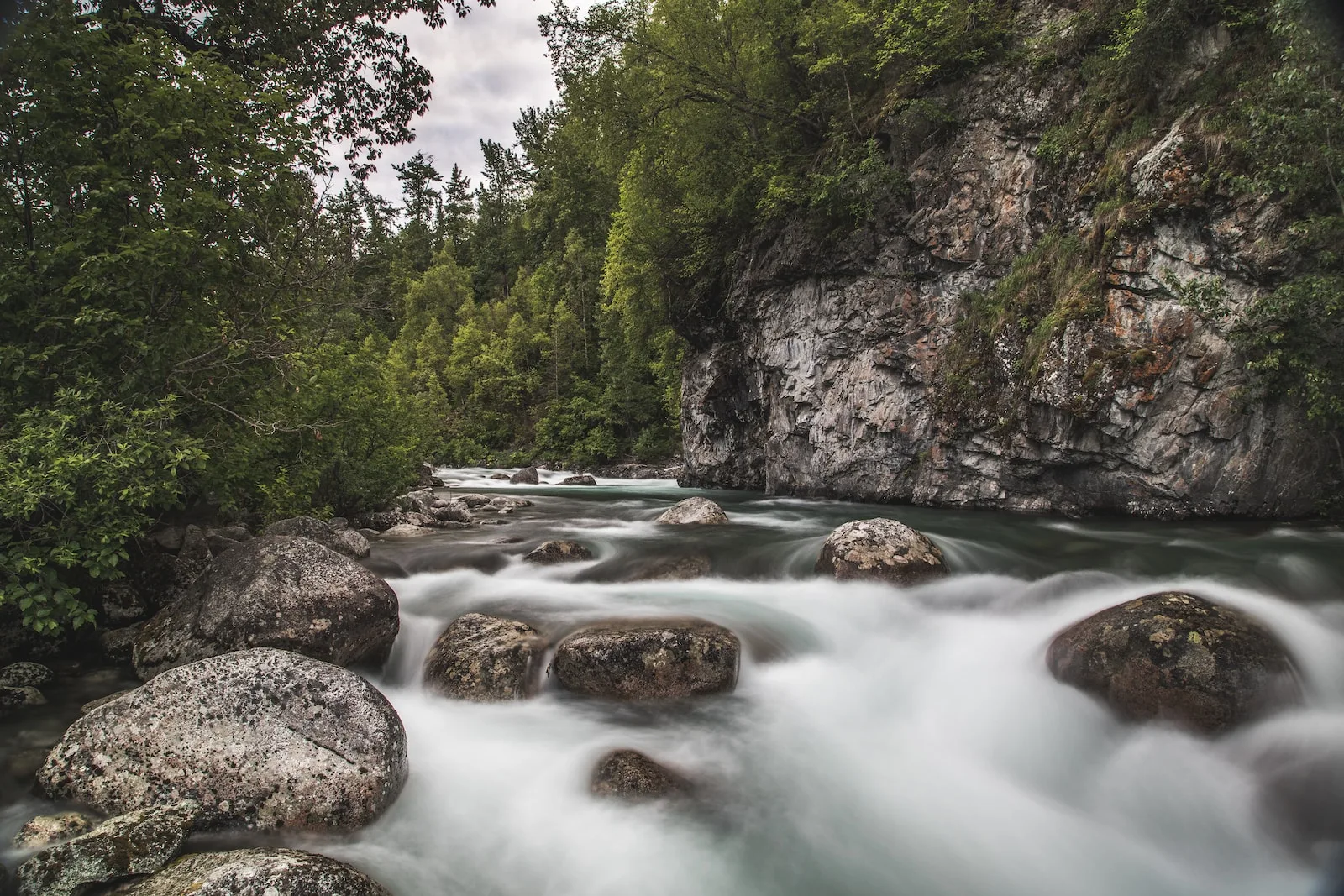A Preliminary Glance at Rivers and Streams
Rivers and streams, the sine qua non of this terrestrial sphere, represent significant geographical features that weave their way across continents. At first blush, these two seem to be virtually identical — both are flowing bodies of water, after all. However, when you delve deeper into the minutiae of their characteristics and functions in the natural world, some remarkable differences come to light.
Rivers are typically characterized as larger bodies of water with significant flow and a wide array of geographical features. Their source can often be traced back to springs or glaciers nestled within mountainous regions.
Their journeys can span thousands of kilometers before terminating in a larger body of water such as a sea or an ocean. Iconic rivers like the Nile, Amazon, and Mississippi truly underscore the grand scale these bodies can achieve.
Streams on the other hand are generally smaller in size. They too originate from springs but may also form where rainfall or melted snow collects and flows along depressions on land surfaces.
Streams usually feed into larger bodies like rivers or lakes and have shorter courses compared to rivers. Well-known streams such as Black Moshannon Creek in Pennsylvania or Laughing Whitefish River in Michigan embody the traits commonly associated with streams.
The Imperative for Understanding River-Stream Differences
Why bother delineating between rivers and streams though? Apart from being intellectually interesting for geography buffs, understanding these differences has tangible real-world connotations too.
From an ecological perspective, differentiating between rivers and streams is crucial because they harbor distinct forms of biodiversity which are intrinsic to ecosystems’ health worldwide. For example, certain species might thrive only in river habitats while others prefer stream environments due to variations in water velocity, depth or local geography.
Moreover, recognizing these distinctions aids us in better utilizing these resources sustainably while ensuring minimal impact on their health; whether it’s harnessing their hydraulic energy for power generation or utilizing them for irrigation purposes – understanding their unique characteristics is key. In essence then – rivers versus streams is more than just an exercise in semantics; it is fundamentally about comprehending our natural world more intimately so we can better preserve its treasures for future generations.
Exploring the Majestic Rivers
The Very Definition of a River
A river, in essence, is an extensive natural stream of water flowing continuously towards the ocean, a lake, or another larger body of water. The size of a river is typically substantial, and its flow is consistent and unidirectional.
Notably, rivers span far and wide across continents, carving their path through diverse landscapes. Rivers play a significant role in shaping geographical features.
Over centuries, their relentless flow erodes the land which results in valleys and canyons. Furthermore, they carry sediments downstream that eventually create fertile deltas teeming with life at their mouths.
The Rivers’ Royal Role: Famous Rivers Worldwide
The longest river worldwide is the Nile River in Africa with an astonishing length of about 4,135 miles. The Amazon River in South America may not be as long as the Nile; however, it holds more water than any other river on Earth.
In Asia, the Yangtze River stands out for its length and ecological richness while North America boasts the Mississippi River–a key player in U.S history and economy. Europe’s longest river ‘Volga’ plays a vital role in Russia’s commerce sector.
Rivers: The Lifelines of Ecosystems
Biodiversity Hubs: Life Alongside A River
Rivers are lifelines to terrestrial ecosystems – acting as conduits for nutrients while providing habitats for diverse species. From microscopic organisms to large predators such as crocodiles or bears; from mangrove trees to brightly blooming flowers – rivers host an array of life forms.
Each segment of a river – from the source to its mouth- accommodates different species adapted to varying environments within this continuum. These dynamic habitats ultimately contribute to enhancing biodiversity at multiple scales.
Rivers’ Contribution: An Essential Cog in Water Cycle
Rivers play an integral role in Earth’s water cycle – they transport precipitation from land back into our oceans – completing nature’s perfect recycling process. This movement distributes freshwater across continents thereby supporting both terrestrial and aquatic ecosystems. Besides transporting freshwater back into seas or oceans – some part gets evaporated back into atmosphere contributing to cloud formation which then precipitates back onto land– thus maintaining Earth’s hydrological balance—truly an ecological marvel!
River Interactions Through Human History
Aquatic Highways: Rivers As Navigation Channels
Since time immemorial rivers have served humanity as vital transportation networks enabling trade & cultural exchange among distant lands—such routes are often referred to as aquatic highways. Ancient civilizations like those on Nile delta or along Indus thrived due this accessibility provided by rivers Today modern society still relies greatly on these natural lanes – barges laden with goods traverse mighty Mississippi while tourist boats meander down Seine offering breathtaking views Parisian landmarks!
Powering Life: Hydroelectricity from Rivers’
Humanity has harnessed power rivers by constructing dams that convert kinetic energy flowing waters into electricity—a clean renewable source power commonly known hydroelectric power! From Hoover Dam on Colorado River Itaipu Dam border Brazil Paraguay – these engineering marvels generate significant amounts electricity supporting millions households around globe While construction dams brings benefits it also incurs environmental costs including disruption fish migration habitat degradation Today increasing emphasis sustainable practices ensure we continue enjoy bounties these beautiful bodies water without compromising future generations
Unraveling the Mystique of Streams
Definition of a Stream
A stream, often considered a minor body of water compared to its larger counterparts, is defined as a small, narrow river. They are typically shallow and can be easily traversed by individuals on foot or in small boats.
Their size may be diminutive, but their role in the overall health and biodiversity of our planet is undeniably significant. The flow of streams varies depending upon various factors such as rainfall, snowmelt or the type of terrain they traverse.
They generally originate from underground water sources in mountains or hills and flow along a channeled path towards rivers or oceans. The geographical features surrounding streams – including their bed composition (such as sand, gravel or mud), bank vegetation and meandering paths – play crucial roles in determining their ecological characteristics.
World-renowned Streams: Nature’s Hidden Treasures
There are countless well-known streams dissecting every corner of our globe; each with its own unique attributes. One inspiring example is the Laboule Stream in Haiti that supplies clean drinking water to thousands while also providing an ideal habitat for flora and fauna. Similarly, Slough Creek meanders through Yellowstone National Park offering breathtaking vistas and abundant fishing opportunities.
Across continents, Europe’s celebrated Danube Delta hosts countless smaller streams that serve as critical wildlife corridors amidst one of the world’s largest wetland reserves. These instances only scrape the surface when it comes to highlighting these remarkable freshwater sources hidden across our diverse landscapes.
The Ebb and Flow: Ecological Roles of Streams
Biodiversity Thriving Within Stream Habitats
Streams serve as vital reservoirs for biodiversity – they harbor a wide array of aquatic organisms from microscopic algae to conspicuous amphibians and fish species like trout or salmon that depend on these environments for spawning purposes. The riparian zones surrounding streams also teem with life; they are home to various birds seeking insects for food as well as mammals who find refuge near this abundant source of fresh water. Furthermore, stream habitats often serve as ecological connectors bridging terrestrial ecosystems with larger bodies like rivers and oceans through corridors facilitating migration patterns for many species – thus fostering an interconnected web promoting genetic diversity at both local and regional scales.
Streams: Crucial Contributors to Groundwater Recharge
Streams play an instrumental role in replenishing groundwater levels – a process known as groundwater recharge where surface water infiltrates into underlying aquifers via streambeds maintaining stable water tables beneath them thereby safeguarding against droughts while also ensuring consistent supply to wells intended for human consumption. This function establishes streams not merely passive conduits channelizing runoff towards larger bodies but dynamic systems interacting intimately with subsurface hydrological processes profoundly affecting both quality and quantity aspects tied to precious groundwater resources.
Fathomless Interactions: Humanity & Streams
Sustenance from Streams : Freshwater Lifelines
For centuries humans have relied heavily on streams for myriad needs including drinking water supply– drawing directly from them owing to their freshwater status contrasting saline oceans . Many rural communities still fetch daily supplies from nearby streams ensuring sustenance while urban areas rely indirectly through public distribution networks sourcing this vital resource from upstream catchments involving mountainous brooks playing key roles in urban hydrologic cycles . Moreover , recreational activities like fishing , kayaking , hiking alongside stream paths largely enrich human lives imbibing physical wellbeing along with mental respite offered by these serene settings .
The Footprint Left Behind : Human Impact on Streams
Human interaction has unfortunately not always been benign . Pollution triggered by industrial waste effluents , sewage disposal , plastic littering severely contaminates stream waters posing dire threats not just aquatic life but farther downstream impacting humans consuming this tainted resource .
Similarly damming alters natural flow regimes devastating fauna dependent upon certain discharge patterns besides inducing sediment buildups stunting ecological progress downstream . Comprehensive strategies entailing policy interventions alongside grassroots participation remain essential towards preserving these invaluable lifelines sustaining life across earth’s diverse corners.
Profound Differences in Physical Characteristics
The physical characteristics of rivers and streams, though they may appear similar on a superficial level, are vastly different upon closer inspection. Rivers, with their greater width, depth, and length present an imposing spectacle of natural power. They carve deep channels into the face of the Earth’s terrain over time.
Streams, by contrast, are smaller in all these aspects but display an unmatched charm in their meandering paths across landscapes.Another remarkable difference is the flow velocity.
This depends largely on the gradient or slope of the land they traverse. Whilst rivers often have lower gradient and consequently slower velocity compared to streams with steep gradients, they carry a larger volume of water due to their size.
The sediment transport capacity also differs between rivers and streams. Rivers carry a larger amount of sediment due to their extensive catchment area while streams typically transport smaller amounts.
Ecosystems’ Dependence: Ecological Roles of Rivers and Streams
In terms of biodiversity, both rivers and streams harbor unique ecosystems teeming with diverse life forms ranging from microbes to larger fauna like fish and otters. However, due to their differing sizes and climatic regions traversed by them; rivers usually host more diverse species as compared to streams.
In addition to habitat provision, both these water bodies play crucial roles within the water cycle – acting as pathways for precipitation back into the seas thereby facilitating evaporation again; however here too differences arise owing largely to size – whilst rivers contribute significantly more towards overall oceanic input than do streams due its higher volume flow rate.
Critical Human Usage: Comparing Roles as Resources
Rivers have been long associated with human civilizations; providing fresh drinking water supply, fertile lands for agriculture besides facilitating trade through inland navigation routes while hydroelectric power generation uses the high flow rates inherent in river systems for energy production. On the other hand, streams too hold immense value – mostly rural communities rely on them for daily household needs including irrigation purposes.
The impact humans have had on these natural resources is unfortunately more severe on rivers due primarily again to size- from pollution loads carried downstream impacting freshwater ecology severely besides increased risk during floods resulting from unplanned urban development along riverbanks compared lesser so in case of relatively unaffected stream systems mainly located away from major urban centers.
Conclusion
Our interactions with our planet’s abundant natural resources need a careful balancing act indeed – understanding differences between them – integral as we strive towards sustainable coexistence. It is heartening however seeing increasing awareness levels today around ecosystem conservation needs – holding promise for prioritizing maintaining healthy river-stream systems vital not only supporting rich biodiversity but indeed our very own survival!




